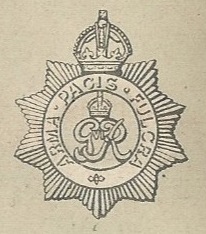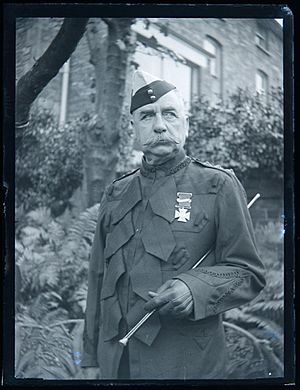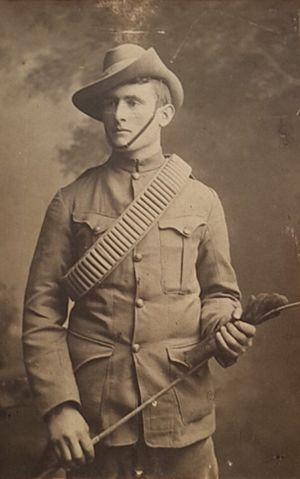North Somerset Yeomanry facts for kids
Quick facts for kids North Somerset Yeomanry |
|
|---|---|

Badge of the North Somerset Yeomanry
|
|
| Active | 1798–present |
| Country | |
| Branch | |
| Type | Yeomanry |
| Size | Regiment |
| Part of | 4th Yeomanry Brigade 1st South Western Mounted Brigade 4th Cavalry Brigade Royal Corps of Signals Royal Armoured Corps |
| Engagements | Second Boer War First World War
|
| Battle honours | See battle honours below |
| Commanders | |
| Colonel of the Regiment |
Brigadier Nigel C. Beacom, QVRM, TD |
| Notable commanders |
Thomas Strangways Horner Sir William Miles, 1st Baronet Richard Boyle, 9th Earl of Cork and Orrery Charles Boyle, Viscount Dungarvan |
The North Somerset Yeomanry was a special part-time cavalry group in the British Army. It existed from 1798 to 1967. This group helped keep order in Somerset before there were proper police forces. Its members also volunteered to fight in the Second Boer War and served on the Western Front during the First World War.
When the Second World War started, they still used horses for a short time. Later, they became a special signals unit, helping with communications. After the war, they joined the Royal Armoured Corps (which uses tanks) and then became infantry (foot soldiers). Today, their history is carried on by 93 (North Somerset Yeomanry) Squadron of 39 (Skinners) Signal Regiment.
Contents
Early Days: French Wars
When Britain was fighting in the French Revolutionary Wars, the government decided to create local cavalry groups. These groups, called Yeomanry Cavalry, would protect the country from invasion. They would also help control any civil unrest.
In 1798, people in Frome, Somerset, decided to form their own military group. This group was called the Frome Troop of Cavalry. They agreed to serve, but only within 10 miles of Frome. Other similar troops were formed in nearby towns like Bath and Mells.
These independent troops were disbanded in 1802 when there was a short period of peace. However, war with France started again in 1803. The Frome volunteers quickly offered their services once more. They became the Frome Selwood Troop of Volunteer Cavalry. By 1814, many of these local troops joined together to form the North Somerset Yeomanry. It had six troops, including two from Frome and two from Mells. More troops from places like Bath and Bristol joined later.
The 1800s: Keeping the Peace
Even after the wars with France ended, the North Somerset Yeomanry remained strong. They were often called upon to stop riots. They helped control unrest in Bath in 1810, 1812, and 1817. They also dealt with miners' riots in Radstock and weavers' riots in Frome. Their actions in the 'Battle of Frome' in 1816 were even discussed in newspapers.
By 1817, the regiment was organized into different squadrons. Later, in 1819, they changed to two main divisions: the Bath Division and the Frome Division.
From 1820 to 1840, their main base was at Mells Park. This was the home of Thomas Strangways Horner, who led the regiment for many years. Another important leader was Richard Boyle, 9th Earl of Cork and Orrery.
One troop, the Keynsham Troop, struggled for a while. Their discipline wasn't great, and they were even called 'The Cossacks' by locals. They were disbanded in 1842, but many of their members joined other parts of the regiment. In 1854, when the Crimean War began, most of the regiment's men volunteered to serve anywhere in the United Kingdom.
Towards the end of the 1800s, the Yeomanry regiments were grouped into brigades for training. The North Somerset Yeomanry and the West Somerset Yeomanry formed the 4th Yeomanry Brigade.
The Imperial Yeomanry and the Boer War
The Yeomanry units were not originally meant to fight overseas. However, during the Second Boer War in South Africa, Britain needed more soldiers. So, in December 1899, the government decided to allow volunteer forces to serve abroad. This led to the creation of the Imperial Yeomanry (IY).
Existing Yeomanry regiments were asked to provide companies of about 115 men each. Many British citizens also volunteered to join this new force. The first groups of IY soldiers arrived in South Africa between February and April 1900.
The North Somerset Yeomanry formed the 48th (North Somerset) Company for the Imperial Yeomanry. This company arrived in South Africa in March 1900. They served until 1901 and earned the regiment its first special recognition: South Africa 1900–01. The regiment's leader, Viscount Dungarvan, also served in South Africa.
The Imperial Yeomanry were trained to fight on horseback, like mounted infantry. After the Boer War, all Yeomanry regiments were called Imperial Yeomanry until 1907. They had a headquarters and four squadrons, plus a machine gun section.
The Territorial Force
In 1908, the Imperial Yeomanry became part of the new Territorial Force (TF). This was a home defense force. The North Somerset Yeomanry (TF) was linked to the regular Dragoons (a type of cavalry).
Their main headquarters was in Shepton Mallet, later moving to Bath. They had squadrons in different towns like Bath, Weston-super-Mare, Shepton Mallet, and Bristol. Each squadron also had smaller groups in nearby villages. The North Somerset Yeomanry was part of the TF's 1st South Western Mounted Brigade.
First World War Service
Joining the Fight
When the First World War began on August 4, 1914, the North Somerset Yeomanry was called into action. The Territorial Force was meant for home defense. However, many units volunteered to serve overseas.
To manage this, the War Office created '2nd Line' units for those who volunteered for overseas service. These units had the same name but with a '2/' prefix (e.g., 2/1st North Somerset Yeomanry). Later, a '3rd Line' was formed to train replacements for the other two lines.
1/1st North Somerset Yeomanry in France
The main regiment, the 1/1st North Somerset Yeomanry, went to Bath in August 1914. In November, they landed in France and joined the 6th Cavalry Brigade. This made them one of only six Yeomanry regiments to join a regular cavalry division during the war.
Life in the trenches meant there wasn't much chance for cavalry to fight on horseback. Still, in 1915, the regiment fought in the Second Battle of Ypres and the Battle of Loos. In 1917, they saw action in the Battle of Arras. At other times, they fought in the trenches as dismounted soldiers.
In March 1918, the regiment was split up. Each squadron joined a different regular cavalry regiment in the 6th Cavalry Brigade.
2/1st North Somerset Yeomanry at Home
The 2nd Line regiment was formed in 1914. They stayed in England, moving between different areas like Calne, Canterbury, and Colchester. In 1916, they became a cyclist unit. Later, they merged with another regiment to form the 10th (Wiltshire and North Somerset) Yeomanry Cyclist Regiment.
In 1917, they went back to being the 2/1st North Somerset Yeomanry. Early in 1918, they moved to Dublin, Ireland, where they stayed until the war ended. The regiment was disbanded in June 1919.
3/1st North Somerset Yeomanry: The Reserves
The 3rd Line regiment was formed in 1915. Their job was to train new soldiers and provide replacements for the 1st and 2nd Line regiments. They were based at Tidworth.
Between the World Wars
After the First World War, the regiment reformed in 1920. Military leaders decided that there were too many cavalry units. Only the 14 most important regiments were kept as cavalry. The North Somerset Yeomanry was the 11th most important, so they remained a cavalry unit with horses.
Second World War Service
Middle East and Syria
The North Somerset Yeomanry still used horses when the Second World War began. In January 1940, they left the United Kingdom and arrived in Palestine. They served there as a garrison force, helping to relieve regular army units.
In June and July 1941, they fought against the Vichy French forces in Syria. Their bravery earned them several awards, including a Military Cross and Military Medals.
The plan was to turn their division into an armoured (tank) division. However, there weren't enough tanks available. So, in September 1941, the North Somerset Yeomanry joined the Royal Armoured Corps. But they still didn't get tanks. They remained in Syria until December 1941, then returned to Palestine.
Becoming a Signals Unit
On February 10, 1942, the regiment was told they would become an Air Formation Signals (AFS) unit. This meant they would provide communications for the Royal Air Force (RAF) overseas. On February 13, they gave up their last horses and began training with the Royal Corps of Signals. They officially became 4th Air Formation Signals (North Somerset Yeomanry) on March 21, 1942.
Some officers were not happy about this change. They felt their men were too highly educated for this new role. However, the new role was actually very technical and important. To keep their team spirit, only a few new officers and non-commissioned officers from the Royal Signals joined them.
4th Air Formation Signals (North Somerset Yeomanry) in Action
AFS units were responsible for providing all communications (except wireless) for the RAF. This included telephone lines, telegraph lines, and despatch riders (who delivered messages). The 4th AFS (NSY) supported the Desert Air Force (DAF) during the fast-moving battles in the Western Desert Campaign.
As the Eighth Army and DAF advanced, new airfields were set up quickly. This put a lot of pressure on the AFS units to keep communications working.
The 4th AFS (NSY) served throughout the North African Campaign, including the Alamein and the advance into Tunisia. They then moved on to the Allied invasion of Sicily and most of the Italian Campaign. In August 1944, after four and a half years overseas, the unit was sent home. Most of its members then joined 14th AFS Regiment, serving in North West Europe until the war ended.
After the Wars
Royal Armoured Corps Again
After the Second World War, the regiment returned to the Royal Armoured Corps. They became the armoured regiment for the 16th Airborne Division. In 1955, they merged with another tank regiment to become the North Somerset Yeomanry/44th Royal Tank Regiment. In 1965, their name changed again to the North Somerset and Bristol Yeomanry.
In 1967, when the Territorial Army was reorganized, the regiment merged with the West Somerset Yeomanry and another infantry battalion. They became A Company (North Somerset and Bristol Yeomanry) in a new combined unit.
39th Signal Regiment 'Skinners'
In 2000, the name North Somerset Yeomanry was brought back for the Headquarters Squadron of 39 (Skinners) Signal Regiment. In 2008, this squadron became 93 (North Somerset Yeomanry) Squadron, which is the Regiment's Support Squadron today.
Uniforms Through Time
The North Somerset Yeomanry's uniforms changed a lot over the years.
- Early Days: The Frome Troop first wore a light cavalry helmet, a blue jacket, and buff (light brown) trousers. Later, they changed to a scarlet (bright red) jacket with black details and white trousers.
- 1820s: They adopted a uniform similar to regular Light Dragoons. This included a blue jacket with red details and grey trousers with a red stripe.
- Mid-1800s: They started wearing a heavy Dragoon helmet made of white metal with a black plume (feather). The jacket became plain blue.
- Late 1800s: A new light dragoon tunic with fancy lacing was introduced. They also wore a blue pillbox hat. In 1888, their uniforms changed again to match the 6th Dragoon Guards. This included a white metal Dragoon helmet with a white plume, a blue Dragoon tunic with white details, and blue trousers with double white stripes. They even had a red cavalry cloak!
- Early 1900s: When they became Imperial Yeomanry in 1902, their fancy full dress uniforms were replaced with Khaki service dress. This included four-pocket jackets and breeches, worn with a Slouch hat that had a white-over-scarlet plume. Later, a peaked service cap was used. By 1906, a blue parade uniform was brought back for special events.
Battle Honours
The North Somerset Yeomanry earned special recognition for their bravery in battles. These are called battle honours. The ones in bold are displayed on their regimental flag (guidon):
| Second Boer War | South Africa 1900–01 |
| First World War | Ypres 1914 '15, Frezenberg, Loos, Arras 1917, Scarpe 1917, Amiens, Hindenburg Line, Beaurevoir, Cambrai 1918, Pursuit to Mons, France and Flanders 1914–18 |
| Second World War | Jebel Mazar, Syria 1941
Honorary Distinction: Badge of the Royal Corps of Signals with year-date "1942–45" and four scrolls: "North Africa", "Sicily", "Italy", "North-West Europe" |
Leaders of the Regiment
Many important people served as the leader or Honorary Colonel of the North Somerset Yeomanry. Some notable ones include:
- Thomas Strangways Horner (1804–1839)
- Sir William Miles, 1st Baronet (appointed 1843)
- Richard Boyle, 9th Earl of Cork and Orrery (Hon Col 1893–1904)
- Field Marshal Frederick Roberts, 1st Earl Roberts, VC (Hon Col 1904)
Memorial
There is a memorial to the North Somerset Yeomanry at the Bishops Hull Army Reserve Centre in Taunton Deane. It is a wooden camp letter box with bronze panels. These panels list the names of 99 members who died in the First World War and 28 who died in the Second World War.
In Popular Culture
The Hollywood movie War Horse (2011) showed a made-up story about the regiment in France in 1914.
See also
- Imperial Yeomanry
- List of Yeomanry Regiments 1908
- Yeomanry
- Yeomanry order of precedence
- British yeomanry during the First World War
- Second line yeomanry regiments of the British Army



